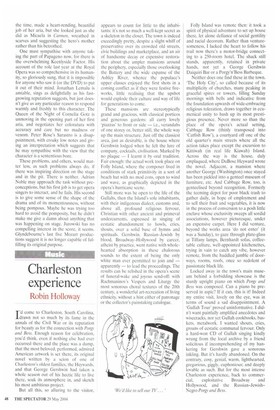Charleston experience
Robin Holloway
I'd come to Charleston, South Carolina, drawn not so much by its fame in the annals of the Civil War or its reputation for beauty as for the connection with Porgy and Bess. Enough reason for celebration, you'd think, even if nothing else had ever occurred there and the place was a dump, that the most beloved, performed, admired American artwork is set there, its original novel written by a scion of one of Charleston's oldest families, the Heywards, and that George Gershwin had taken a whole season out of his hectic life to live there, soak its atmosphere in, and sketch his most ambitious project.
But all this, so alluring to the visitor, appears to count for little to the inhabitants: it's not so much a well-kept secret as a skeleton in the closet. The town is indeed exceedingly pretty, despite a slight whiff of preservative over its crowded old streets, civic buildings and marketplace, and an air of handsome decay or expensive restoration about the ampler mansions around the periphery, especially those overlooking the Battery and the wide expanse of the Ashley River, whence the populace's upper classes enjoyed the first shots in a coming conflict as if they were festive fireworks, little realising that the upshot would explode their culture and way of life for generations to come.
These mansions are stereotypically grand and gracious, with classical porticos and generous gardens: all carry lovely 'piazzas' to front or side — i.e., verandahs of one storey or, better still, the whole way up the main structure. Just off the classiest area, just as desirable, is the house where Gershwin lodged when he felt the lure of company, cocktails, civilisation. Marked by no plaque — I learnt it by oral tradition. Fair enough: the actual work took place on Folly Island, where the composer lived in conditions of stark primitivity in a sort of beach hut with no mod cons, open to wind and wave, as graphically depicted in the opera's hurricane scene.
Still more was he open to the life of the Gullahs, then the Island's sole inhabitants, with their indigenous dialect, customs and, above all, profound religious fervour, Christian with other ancient and primeval undercurrents, expressed in singing of ecstatic abandonment to howls, cries, shouts, over a solid base of hymns and spirituals. Gershwin. Russian-Jewish by blood, Broadway-Hollywood by career, atheist by practice, went native with wholehearted absorption in these chalorous sounds to the extent of being the only white man ever permitted to join and — apparently — to lead the proceedings. The results can be relished in the opera's scene of funeral-wake and joyous send-off: with Rachmaninov's Vespers and Liturgy the most sonorous choral textures of the 20th century, a wonderful art-recreation of living ethnicity, without a hint either of patronage or the collector's painstaking catalogue. Folly Island was remote then: it took a spirit of physical adventure to set up house there, let alone defiance of social gentility and racial decorum. Rather than venturesomeness, I lacked the heart to follow his trail now there's a motor-bridge connecting to a 250-room hotel. The shack still stands, apparently, retained in private hands, not yet a George Gershwin Daiquiri Bar or a Porgy'n'Bess Barbeque.
Neither does one find these in the town. 'The Holy City', so called because of its multiplicity of churches, many peaking in graceful spires or towers, filling Sunday mornings with bells and indicative from the foundation upwards of wide-embracing religious toleration, draws together in ecumenical unity to hush up its most prestigious presence. Never more so than the place of the opera's actual setting, Cabbage Row (thinly transposed into 'Catfish Row'), a courtyard off one of the old quarter's main streets where all the action takes place except the excursion to Kittiwah (in real life Kiawah) Island. Across the way is the house, duly emplaqued, where DuBose Heyward wrote the novel. Adjacent, a mansion where another George (Washington) once stayed has been pickled into a genteel museum of furniture, etc. And Cabbage Row, too, is genteelised beyond recognition. Formerly the teeming depot for poor black trash to gather daily, in hope of employment and to sell their fruit and vegetables, it is now in the process of conversion to a posh little enclave whose exclusivity sweeps all sordid associations, however picturesque, under an expensive carpet. Here I did venture, beyond the works area 'do not enter' (it was a Sunday), to gaze through plate-glass at Tiffany lamps, Bernhardt sofas, coffeetable culture, well-appointed kitchenettes, trying in vain to catch any vibe, however remote, from the huddled jumble of doorways, rooms, roofs, once so redolent of passionate black life.
Locked away in the town's main museum behind a forbidding showcase is the sturdy upright piano on which Porgy and Bess was composed. Can a piano be preserved in aspic? If it can, this is it! Indeed my entire visit, lovely on the eye, was in terms of sound a sad disappointment. A `Gullah Tour' proved uninformative. I didn't want painfully amplified anecdotes and wisecracks, nor yet Gullah cookbooks, baskets, metalwork. I wanted shouts, cries, groans of ecstatic communal fervour. Only a hard-won CD of Gullah singing kindly wrung from the local archive by a friend solicitous if incornprehending of my hankering for Gershwin gave a sonorous inkling. But it's hardly abandoned. On the contrary, cosy, genial, warm, lighthearted, gregarious, giggly, euphonious; and deeply lovable as such. But for the most intense Charleston experience, back to commer cial, exploitative Broadway and Hollywood, and the Russian-JewishNegro Porgy and Bess.


































































 Previous page
Previous page